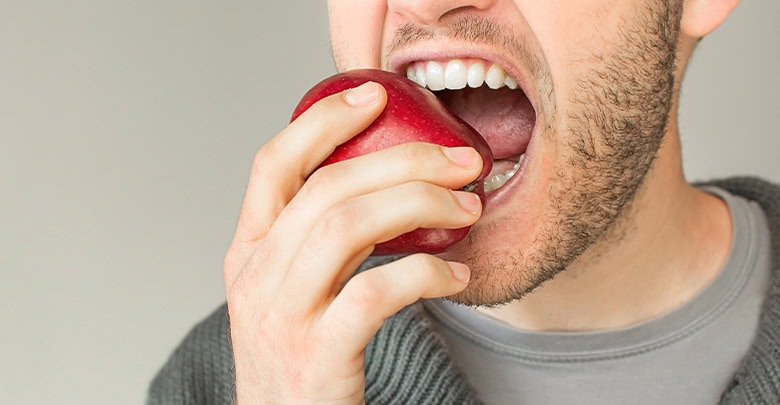Dietary Fiber: Why it Does & Doesn’t Affect Your Blood Sugar
‘Net carbs’ is good marketing but be aware of the actual impact on your blood sugar, which can be surprising in ‘low-carb’ products

In your first carb-counting class as a person with type 1 diabetes, you were likely taught to subtract the dietary fiber from the total carbohydrate count in order to calculate your insulin dose.
Dietary fiber is part of that total carbohydrate count but it’s generally not broken down into glucose and digested like other types of carbohydrates.
This means that you can subtract the “dietary fiber” grams from the “total carbohydrate” grams to get the “net” carbohydrate count — the number of carbohydrate grams that are expected to impact your blood sugar and require insulin in order to properly metabolize.
For example, 1 medium Fuji apple contains approximately:
- 30 grams of total carbohydrate
- 4 grams of dietary fiber
- = 26 “net” carbohydrates
4 grams isn’t going to make a huge difference in terms of insulin dosing and the effects of that apple on your blood sugar, however, your overall gut health, sense of “fullness” after eating,
Net Carbs is a marketing term
It’s important to remember where the term “net” carbs came from.
“Net carbs is a term that food manufacturers coined,” explains Jennifer Okemah, MS, RD, BCADM, CDE CSSD in Type 2 Nation’s article, Low-Carb Pasta Options.
“The human body does not calculate ‘net carbs.’ The intestinal lining does, in fact, absorb some fibers. That being said, higher intact fiber has many benefits on satiety, blunting the blood sugar spikes and lowering cholesterol. Just remember, when dosing your insulin or measuring your blood sugar, that the gut does not do the math and come up with ‘net carbs’.”
That being said, it’s still important to be aware of the total fiber count in the meal you’re eating as a person with diabetes because the larger the fiber quantity, the more it can impact your insulin needs.
Eating plenty of fiber via vegetables, fruits, grains, seeds, and nuts is easy if your diet consists of mostly real, whole food.
Added fiber in processed “low-carb” products
Nowadays, there is so much fiber product added to low-carb products that things can get a little confusing when you’re dosing insulin for 10 net carbs only to see the impact on your blood sugar as though it were actually 20 grams.
So here’s the catch when it comes to fiber.
Some of that fiber is still broken down into glucose. And these high-fiber products that contain large quantities of highly processed fiber are the biggest culprits.
Take a look at the nutrition profile in this edamame pasta:
- 21 grams of total carbohydrate
- 12 grams of dietary fiber
- = 9 grams “net” carbs
Personally, I can tell you that the impact of those 9 grams of carbohydrates affects my blood sugar more like it’s about 15 grams of carbohydrate. Still far easier to manage my diabetes around that a bowl of heavily processed, starch-laden wheat or rice pasta, but not nearly as “low impact” as many high-fiber products like this claim to be.
Other high-fiber products include protein bars, protein powders, bread, tortillas, and diet-like desserts. (Read more in the article on PROTEIN & Blood sugars)
How should you count fiber when calculating insulin?
Unfortunately, there is no easy answer to this question. But here are a few tips when you’re consuming a whole food or product with ‘high fiber’:
- Take good notes! Write down the food item, the “net” carbs, how much insulin you took…and then what happened! Could you dose your insulin by the “net” carb-count or did you need more than expected? Next time you eat that item, you’ll know how to manage your insulin dose.
- Treat each high-fiber food as different than the last. In addition to the fiber in an apple being different than the fiber in a bowl of black beans, the type of fiber in your Quest Bar could be a different type of fiber than what’s in your favorite low-carb bread. Look at the ingredients to determine what types of fiber you’re consuming, and again…take good notes on how the “net” carbohydrate count impacted your blood sugar.
- The more fiber, the more likely some of it will affect your blood sugar. If there are 10+ grams of fiber in a food or product, the potential for some of that fiber affecting your blood sugar is higher simply because there’s more of it.
Food in our lives with type 1 diabetes is complicated.
At the end of the day, the one thing every nutrition expert can agree on is that we should all strive to eat more real food — especially plants! And thankfully, by eating more plants, you’ll effortlessly get more fiber into your diet.